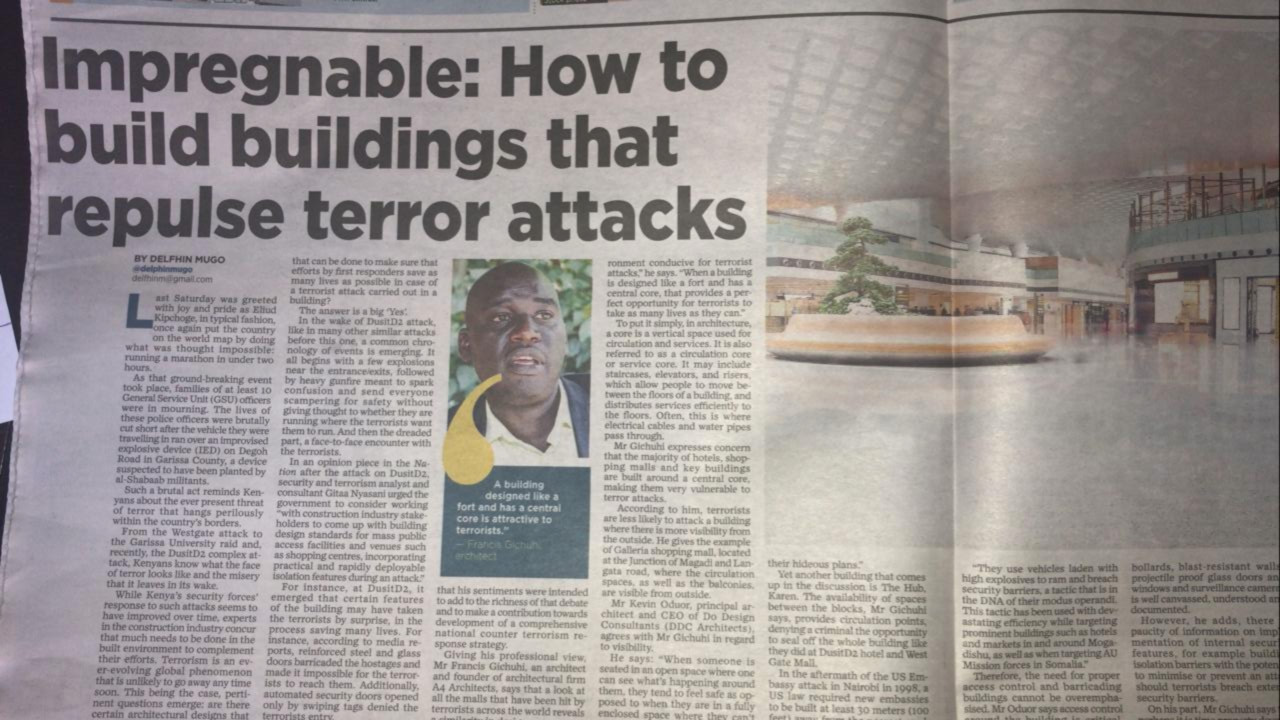https://mobile.nation.co.ke/lifestyle/Constructing-buildings-that-repulse-terror-attacks/1950774-5313474-qgp492/index.html
IN SUMMARY
- The need for proper access control and barricading buildings cannot be overemphasised.
- Terrorism is an ever-evolving global phenomenon that is unlikely to go away any time soon.
- At DusitD2, it emerged that certain features of the building may have taken the terrorists by surprise, in the process saving many lives.
ADVERTISEMENT
ADVERTISEMENT
Last Saturday was greeted with joy and pride as Eliud Kipchoge, in typical fashion, once again put the country on the world map by doing what was thought impossible: running a marathon in under two hours.
As that ground-breaking event took place though, families of at least 10 General Service Unit (GSU) officers were in mourning. The lives of these police officers were brutally cut short after the vehicle they were travelling in ran over an Improvised Explosive Device (IED) on Degoh Road in Garissa County, a device suspected to have been planted by Al Shabaab militants.
Such a brutal act reminds Kenyans about the ever present threat of terror that hangs perilously within the country’s borders.
WESTGATE ATTACK
From the Westgate attack to the Garissa University attack and recently the DusitD2 complex attack, Kenyans know what the face of terror looks like and the misery that it leaves in its wake.
While Kenya’s security forces’ response to such attacks seems to have improved over time, experts in the construction industry concur that much needs to be done in the built environment to complement their efforts. Terrorism is an ever-evolving global phenomenon that is unlikely to go away any time soon.
This being the case, pertinent questions emerge: are there certain architectural designs that make buildings vulnerable to terror attacks? Also, is there something that can be done to make sure that efforts by first responders save as many lives as possible in case of a terrorist attack carried out in a building? The answer is a big ‘Yes’.
In the wake of DusitD2 attack, like in many other similar attacks before this one, a common chronology of events is emerging.
It all begins with a few explosions near the entrance/exits, followed by heavy gunfire meant to spark confusion and send everyone scampering for safety without giving thought to whether they are running where the terrorists want them to run. And then the dreaded part, a face-to-face encounter with the terrorists.
TERRORISM
In an opinion piece in the Nation after the attack on DusitD2, security and terrorism analyst and consultant Mr Gitaa Nyasani urged the government to consider working “with construction industry stakeholders to come up with building design standards for mass public access facilities and venues such as shopping centres, incorporating practical and rapidly deployable isolation features during an attack.”
For instance, at DusitD2, it emerged that certain features of the building may have taken the terrorists by surprise, in the process saving many lives.

Large open plan office interior without people. PHOTO | AGENCIES
For instance, according to media reports, reinforced steel and glass doors barricaded the hostages and made it impossible for the terrorists to reach them. Additionally, automated security doors opened only by swiping tags denied the terrorists entry.
Speaking to DN2 from Australia, where he is based, Mr Nyasani said that his sentiments were intended to add to the richness of that debate and to make a contribution towards development of a comprehensive national counter terrorism response strategy.
Giving his professional view, Mr Francis Gichuhi, an architect and founder of architectural firm A4 Architects, says that a look at all the malls that have been hit by terrorist across the world reveals a similarity in design.
DESIGN
“There are certain building designs that can make the environment conducive for terrorist attacks,” he says. “When a building is designed like a fort and has a central core, that provides a perfect opportunity for terrorists to take as many lives as they can.”
To put it simply, in architecture, a core is a vertical space used for circulation and services. It is also referred to as a circulation core or service core.
It may include staircases, elevators, and risers, which allow people to move between the floors of a building, and distributes services efficiently to the floors. Often, this is where electrical cables and water pipes pass through.
Mr Gichuhi expresses concern that a majority of hotels, shopping malls and key buildings are built around a central core, making then very vulnerable to terror attacks.
According to him, terrorists are less likely to attack a building where there is more visibility from the outside. He gives the example of Galleria shopping mall, located at the Junction of Magadi and Lang’ata Road, where the circulation spaces as well as the balconies are visible from the outside.
Mr Kevin Oduor, principal architect and CEO of Do Design Consultants (DDC Architects) agrees with Mr Gichuhi in regard to visibility.
HIDEOUS PLANS
He says, “When someone is seated in an open space where one can see what’s happening around them, they tend to feel safe as opposed to when they are in a fully enclosed space where they can’t see what’s happening outside. An attacker will favour a place with less natural surveillance to execute their hideous plans.”
Yet another building that comes up in the discussion is The Hub Karen. The availability of spaces between the blocks, Mr Gichuhi says, provides circulation points, denying a criminal the opportunity to seal off the whole building like they did at DusitD2 hotel and West Gate Mall.
In the aftermath of the US Embassy attack in Nairobi in 1998, a US law required new embassies to be built at least 30 meters (100 feet) away from the nearest road. And it is easy to see why.
Mr Nyasani points out a notorious modus operandi for the Al Shabaab.
“They use vehicles laden with high explosives to ram and breach security barriers, a tactic that is in the DNA of their modus operandi. This tactic has been used with devastating efficiency while targeting prominent buildings such as hotels and markets in and around Mogadishu as well as when targeting AU Mission forces in Somalia.”



Leave a Reply